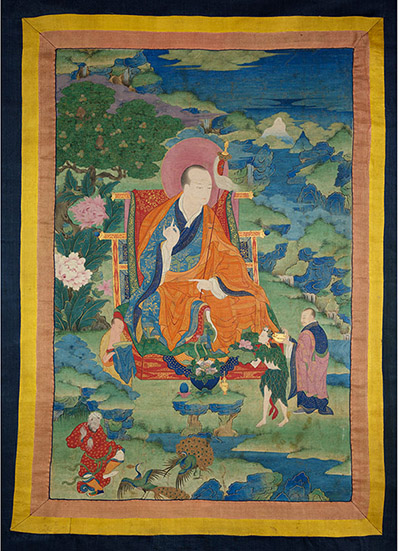CulBeat Express
2018.02.02 18:46
아시아소사이어티 티벳 불교미술전(2/27-5/20)
조회 수 1015 댓글 0
Unknown Tibet: The Tucci Expeditions and Buddhist Painting
On view in New York, February 27-May 20, 2018

Asia Society Museum presents an exhibition featuring more than 50 stunningly beautiful paintings collected by Italian scholar Giuseppe Tucci during his 1926–1948 expeditions to Tibet, along with a selection of striking photos depicting Tucci’s travels.
Works in the exhibition span the 13th through 19th centuries, and are on loan from the Museum of Civilisation-Museum of Oriental Art “Giuseppe Tucci,” Rome.
The exhibition marks the first time they are on view in the United States.
One of the first Westerners to travel to the Tibetan plateau, Tucci led eight expeditions in search of remote monasteries and sacred sites. His extensive knowledge of Tibetan history and religion, and his mastery of Asian languages, including Tibetan and Pali—the language of earliest Buddhist literature—informed his acquisition of artworks. Paintings in the exhibition come from eastern, western, and central Tibet, and show a range of styles and subjects.
The majority of the paintings in the exhibition are religious paintings, intended to aid Buddhist practitioners on their path to enlightenment. Recent conservation of the paintings, many of which had been obscured by exposure to blackening soot and grease in their original temple and monastery settings, has restored much of their original luminescent beauty, sumptuous colors, and gold embellishments. Viewers may easily imagine how these paintings were used as meditational aids by the devoted, who would have been awed by their physical brilliance and spiritual subjects.
The exhibition is the result of thirty years of research and has been organized and adapted for an American audience by guest curator Dr. Deborah Klimburg-Salter, Professor Emeritus, University of Vienna, and Dr. Adriana Proser, Asia Society’s John H. Foster Senior Curator for Traditional Asian Art, for presentation at Asia Society, New York.
A beautifully illustrated book, Discovering Tibet: The Tucci Expeditions and Tibetan Paintings, published in 2016 to accompany the Italian presentation of the works, is available through AsiaStore.
Exhibition organization
Unknown Tibet: The Tucci Expeditions and Buddhist Painting presents the story of two journeys. The first is the story of Tucci’s travels in a land that was traditionally forbidden to foreigners. Throughout the exhibition, enlargements of archival expedition photography are featured—as well as documentary footage of Tibet’s people, landscapes, and monuments at the time of Tucci’s visits—to provide additional context for the paintings.
Nagasena Arhat. 17th century, possibly Kham (East Tibet). Tradition: Gelug. Pigments on cloth. MU-CIV/MAO “Giuseppe Tucci,” inv. 933/766. Courtesy of the Museum of Civilisation-Museum of Oriental Art "Giuseppe Tucci," Rome
The second journey explored is spiritual, and is that of the different paths to Buddhist awakening, or enlightenment. Tibetans recognize two paths to enlightenment: "The Path of the Sutra," and "The Path of the Tantra" (the esoteric path). Each path is based on different sacred texts. A sutra is a discourse attributed to a Buddha (often the historical Shakyamuni Buddha). A tantra is a discourse attributed to a tantric transformation of the Buddha that contains philosophical principals as well as instructions for ritual and meditation.
Among the most visually stunning works in the exhibition is a group of 14 images from a set of 17th century Arhat paintings, in the “Path of the Sutra” section of the exhibition. The large, beautifully painted works feature striking blue and green landscape elements and highly individualized portraits of important followers of the Buddha. Stylistically, the works show a convergence of Tibetan and Chinese painting styles. The works serve as visual guides to understanding the cornerstones, or “Three Jewels” of Buddhism: Buddha, Dharma (the Buddhist teachings), and Sangha (the monastic community).
“The Path of the Tantra” section of the exhibition illustrates the esoteric rituals and meditation practices known as tantras. It consists of paintings of Lamas, Protectors of Personal Practice (yidam), and Protectors of Dharma. The images in this section help practitioners as they move along the path to enlightenment. An exceptional work in this section is a sumptuous 16th to 17th century Central Tibetan Chakrasamvara Mandala. The mandala is in a geometric form with four central circles divided by the eight spokes of the Buddhist wheel, or chakra, which symbolizes the Buddhist doctrine.
The final section of the exhibition, “The Tibetan Cosmos,” helps to put Buddhism and Buddhist art into a broader Tibetan religious and scientific context. The native Tibetan Bon religion—one of the oldest indigenous religions in Tibet—pre-dates the northern advance of Buddhism onto the Tibetan plateau in the seventh century CE. The exhibition explores how Bon and Buddhism influenced one another.
Related programming
Buddhism and Beyond is a season of related programming organized in conjunction with the exhibition, exploring the origins of Buddhism, its practice, and its popularity in contemporary culture.
Highlights include:
The Miracle of Mindful Meditation, a conversation with Dan Harris and Thupten Jinpa, on Thursday, February 15
Walking with Tucci: A Visual History of Tibet, members-only lecture with Deborah Klimburg-Salter, on Tuesday, February 27
Artist Talk with Gonkar Gyatso, on Tuesday, March 6
Shen Wei Dance: Buddhist Interpretations, on Tuesday, March 27
Why Buddhism is True: Robert Wright and Juju Chang, on Tuesday, April 17
Moving Borders: Tibet in Interaction with its Neighbors, a two-day symposium on Friday–Saturday, May 4–5
Mindful Awareness: Weekly Meditation Sessions, on Wednesdays at 12:30
Find out more at AsiaSociety.org/NY
Exhibition support
Major support for this exhibition is provided by the E. Rhodes and Leona B. Carpenter Foundation, John and Fausta Eskenazi, Lisina M. Hoch, and an anonymous donor.
Generous support is provided by Misook Doolittle in honor of Chae Ok Rollison, and Cynthia Hazen Polsky and Leon Polsky.
Additional support is provided by the Ellen Bayard Weedon Foundation, the Blakemore Foundation, Carlton Rochell, and Trace Foundation
Asia Society appreciates the support of Susan L. Beningson and Steve Arons.







